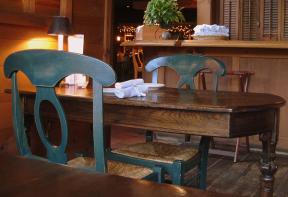Fixing wooden chairs
Assess the harsh effects of winter and determine how to save your seats
My dining-room table, circa 1911, has stood the test of time; solid as ever, it seems to never lose its legs. The chairs, however, have seen better days. The mortise-and-tenon joinery is coming apart and I’m afraid the next time I sit down, I’ll fall to the floor. It’s time to fix these joints.
While wooden chairs can become wiggly from sheer usage, it’s the dry, winter weather that causes the creaks. Canadian homes are at their driest during winter months. This causes indoor wood to shrink, causing adhesives to fail and interlocking joints to move around. Once the wiggling commences, it only gets worse, so the sooner you act, the easier the fix, making this the perfect late-winter weekend project.
Scenario 1: Wee wiggles
If your chair is only just starting to wiggle and the joints are still relatively tight, then you’re in luck and can fix the joints without pulling apart the chair, thanks to a Canadian invention: Chair Doctor, from Lee Valley Tools. Chair Doctor is an opaque, low-viscosity liquid glue held in a needle-ended bottle, which allows you to drip the glue deep into a joint. The thin glue soaks the wood’s end grain, swelling the wood, and then freezes the wood in the swollen state as it cures, leaving you with a rock-solid joint.
The key to using Chair Doctor is to sufficiently wiggle the joint so that the glue penetrates deep into it. Spend about five minutes moving the joint back and forth to work the glue in. Then wipe off any excess glue, lightly clamp the joint and set aside to dry for at least 24 hours.
Scenario 2: Snug, but shaky
If you’re like me, you’ve let things go way too far and the joinery has come apart completely. Naughty, yes, but not beyond repair. If your joints are in this state, the first step to repair is to disassemble the chair, using a rubber mallet if necessary. I know what you’re thinking: Wait, wait, isn’t a complete dismantling a bit extreme?
“It comes down to whether you want it ‘fixed’ or ‘fixed properly,’” says woodworker Ryan Shervill, owner of Rare Wood Creations in Penetanguishene, Ont., and Canadian Home Workshop’s Ask A Pro expert . The best way to ensure a lifetime fix, advises Shervill, is to completely dismantle the joints, clean them well–lightly sand the tenon to get rid of any adhesive residue–before reassembly.
Jump to a section
- Page 1 : Fixing wooden chairs
- Page 2 : Major wooden chair repair
To leave a comment, please log in












No comments